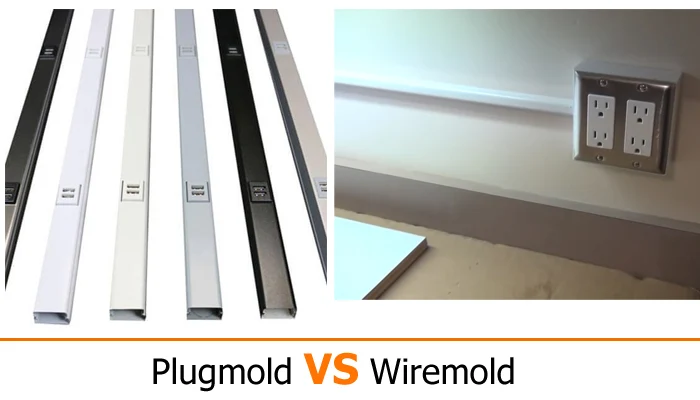Every home needs electrical outlets, but running wires can be a hassle. It’s often difficult to know where to put electrical outlets, and once you do, it can be a pain to run the wires. Plugmold and wiremold make it easy.
Both products manage cords and cables to hide them from view, but each in different ways. Without having to drill holes or run wires through your walls, you can install outlets where you need them.
Choosing between plugmold vs wiremold requires a better understanding of each technique. That’s what we’re here for. Let’s compare and contrast these two methods so you can make an informed decision about which is best for your project.

Here Are the Comparison of Plugmold vs Wiremold
Any homeowner who has struggled to keep cords and cables hidden knows how difficult it can be. Even with the help of furniture placement or rugs, cords tend to stand out like a sore thumb. Not only are they unsightly, but they can also be dangerous if not properly managed.
Let’s take a look at the main differences between plugmold and wiremold:
1. Basics:
Plugmold is a system of electrical outlets that are mounted on a baseboard, cabinet, or under a counter. The outlets are placed along the length of the baseboard or cabinet, and they are connected to each other with short lengths of wire.
On the other hand, wiremold refers to electrical outlets mounted on a wall or ceiling. In most cases, the outlets are placed near the floor so that they are out of the way. The outlet box is recessed into the wall, and the wires are run through the wall to the outlet box.
2. Durability:
One of the most significant differences between plugmold and wiremold is durability. Plugmold is made from plastic, which makes it less durable than wiremold. The wires in a plugmold system are also more likely to become damaged over time.
Wiremold is made from metal, which makes it more durable than plugmold. The metal box encloses the wires and protects them from damage.
3. Applications:
Another difference between plugmold and wiremold is the applications for each system. Plugmold is typically used in residential applications, while wiremold is often used in commercial applications.
You can use either system in a residential or commercial setting, but there are some differences to keep in mind. In a residential setting, plugmold typically appears in kitchens and bathrooms. Wiremold is typically installed in office buildings and hotels.
4. Cost:
The cost of each system is another significant consideration. Plugmold is typically less expensive than wiremold. This is because it is made from less expensive materials like plastic and is less labor-intensive to install.
Compared to plugmold, wiremold is more expensive. Since it is manufactured from more expensive materials such as metal, it is going to be more complicated to install.
Similarities of Plugmold vs Wiremold
Even though there are some key differences between these two types of electrical systems, there are also some similarities. We will now examine a few of the similarities between plugmold and wiremold:
1. Aesthetics:
One similarity with plugmold and wiremold is that they are both designed to be aesthetically pleasing. Both systems hide the cords and cables so that they are not visible. This gives your home a clean and polished look.
2. Functionality:
Another similarly-themed feature is that they both maintain functionality. Both systems allow you to hide wires and cords in order to keep them concealed. Putting them on the wall prevents your home from looking dirty or unkempt.
3. Safety:
A final point of similarity seems to be that both ensure safety. By hiding cords and cables, you can prevent trips and falls. It is especially important in households with small children and pets.
Which is Better?
Now that we’ve looked at the key differences and similarities between plugmold and wiremold, you might be wondering which system is better. The answer to this question depends upon your requirements and preferences.
While both systems have their own advantages, wiremold is typically the better choice for most people. This is because wiremold is more durable and has a higher weight capacity. Wiremold is also less prone to wear and tear.
As an alternative, plugmold is a good choice for a less expensive electrical system. Plugmold is also easier to install, which makes it a good choice for DIYers.
Frequently Asked Questions
If your plugmold constantly pops out of the cabinet, it is likely because it was not installed correctly. Make sure that the screws are tightened properly and that the brackets are in place.
Yes, you can incorporate the plugmold system into your garage. However, it is crucial to make sure that the system is properly grounded.
No, wiremold and plugmold are not good for outdoors. These systems are not weather-resistant and should not be used in outdoor applications or wet areas.
In most cases, you will not need a permit to install a plugmolded or wiremold system. However, it is always best to check with your local building policy to be sure.
To uninstall the plugmold or wiremold cover, first, unscrew the base plate. Then, pull the cover off of the base plate. Finally, release the clamps that hold the wires in place and remove the wires from the system.
Conclusion
Now that you know how plugmold and wiremold differ, you can decide which system is right for your home. If you need a durable and strong electrical system, wiremold is the better choice. However, if you are looking for an electrical system that is less expensive, plugmold might be a good option for you.
Remember, when choosing an electrical system for your home, it is important to consider your needs and preferences. And safety should always be your top priority.
Leave a Reply